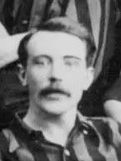Johnnie Auld

Two things stand out about Johnnie Auld's life apart from his round-ball prowess. They are that he repeatedly reported as being a native of Lugar and that after football he ran a shoe and boot business. In fact the two are not unconnected, despite the former not being strictly true.
John Robertson Auld was actually born in Kilmarnock and in 1862. His parents were both relatively local and his father was a shoemaker, later a shoe-manufacturer. And at least two of his children followed him into the trade, one being John. Moreover, he would grow up initially in Killy, in the house next door to Bummer Campbell's until two things happened.
The first is that the parents and some of the siblings moved to Glasgow, to Toryglen and then, possibly quite quickly, to Govanhill. The second is that three of the other siblings, including John and elder brother, Robert, opened a shoe-making business in Lugar and it is at that point that Johnnie's subsequent football career falls into place. He began it, as centre-half but a tough one, at Lugar Boswell, still today with its Rosebank ground, having arrived in the coal and iron village by 1881 at least. He then from 1883 to 1889 played largely for Third Lanark at the first Cathkin Park with 1887 -88 spent at Queen's Park, then at the second Hampden, the second Cathkin, and where he is said to have been a little rough. Both grounds were noticeably within walking distance of his parents' probable address by that time. He could come up for the weekends!
Additionally by 1889 he had already been recognised by the national team, winning two caps in 1887 and third one in 1889 with the most notable event therein being that in the first, and against England, he was not one of a pair of half-backs as had been the norm from 1872 but the middle one of three. He was the centre-half but in a Welsh/English, defensive 2-3-5 that had been adopted everywhere else and had been taking over the Scottish game too but here the following year was be swept aside by The Cross, pivoting around the Renton and subsequently Scottish, attacking centre-half, a tactic and position to which he seems rapidly to have adapted.
Apart from a third cap the other success of 1889 would be that his Third's team would take the Scottish Cup, which seems to be have been the trigger, despite his age, almost twenty-eight, for Sunderland, then non-League, to come in for him. And there he seems to have settled immediately. He would captain the Magpies as they joined the top-flight the following year and be the play-maker, around whom "The Team of All Talents" was assembled. It was in 1890-1 a squad of sixteen, fourteen Scots. The following one it was seventeen and one non-Scot. It would also be the team that in 1892 won the League title for the first time. And that would be the same year Auld would marry, his bride local girl, Ann Gibson, with whom he would have four children, two boys and two girls.
Sunderland would take the League title once more in 1893 and again in 1895, although by then and well into his thirties he played only a bit part. Indeed, he would in 1896 leave the club but definitely not the town, joining Newcastle initially as bit-part player but then off-field becoming a director and taking on a completely novel, non-playing capacity; a proto-Sporting Director. At St. James's until 1906 he was part of a three-man committee there to identify players, perhaps even talent more generally. Under his influence, as at Sunderland, a slew of top-class players were brought in plus the training talents of John Quar McPherson. The results were by 1912 three League titles and runners-up spot and four FA Cup final defeats but finally one trophy.
And it was not as if on finally stepping back from football Auld was inactive. On signing for Sunderland originally part of the package had been the funding in the town of a business, one that he knew well. He would throughout his time on Wearside unsurprisingly have a shoe- and shoe-repair shop, to which he added a second. In 1891 he had even been recorded as a Boot- and Shoe-Healer not a footballer. And it would be as both he would be recalled again on death. That would be still on Wearside too, indeed almost within sight of Roker Park, in 1932, aged seventy, and as a result of a fall from a tram, to be then buried in the town's Mere Knoll Cemetery.
Birth Locator:
1862 - 16, Boyd St, Kilmarnock
Residence Locations:
1871 - 16, Braeside, Kilmarnock
1881 - Rosebank, Lugar, Ayrshire
1891 - (14, Preston St., Govanhill, Glasgow)
1891 - 7, Elizabeth St., Sunderland, Co. Durham
1901 - "Ivanhoe", Park View, Sunderland, Co. Durham
1911-32 - 46, Roker Park Road, Sunderland, Co. Durham
Death Locator:
1932 - 46, Roker Park Road, Sunderland, Co. Durham
Grave Locator:
Mere Knolls Cemetery, Sunderland
Back to the Killy Trail
or the SFHG Home page